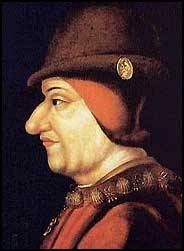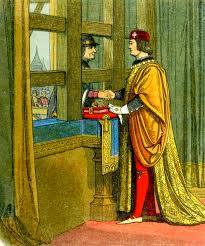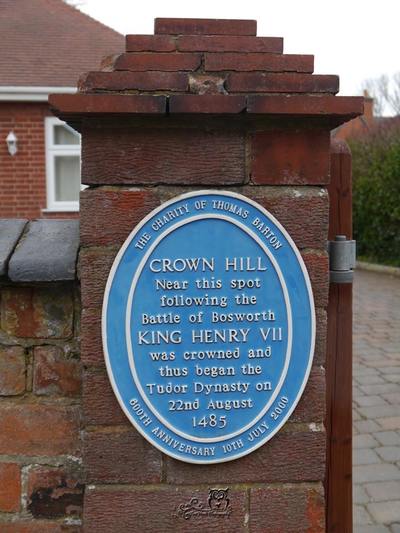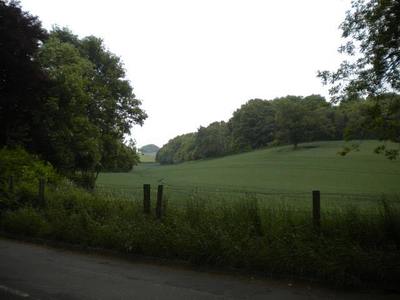Louis is famously known by a number of nick-names, Louis the Prudent for his skills in the world of diplomacy, and for his scheming and plotting he was known as the Universal Spider.
|
30th August 1483, the death Louis XI of France Louis believed that the end justified the means, in 1475 he bought off Edward IV for a payment of 75,000 crowns with the promise of 50,000 a year and the marriage of his son to Edward’s daughter - peace with England meant that he could sort out his problems with Burgundy. His reign saw the beginning of the end of feudalism and he left France in a better position than that of his father. However he had his critics, for modernising the French army with the use of the Swiss idea of a permanent royal infantry and no temporary contracts Machiavelli called him 'shortsighted and imprudent.' Regardless of the fact that he achieved much in his reign, he was overall generally disliked. Louis is famously known by a number of nick-names, Louis the Prudent for his skills in the world of diplomacy, and for his scheming and plotting he was known as the Universal Spider. Loving a good conspiracy did him no good in the end though, he died at the end of August 1483, of what you could argue was the over use of his little grey cells - a brain hemorrhage.
6 Comments
On this day in 1482 the death of the 'She Wolf' Margaret of Anjou age fifty-two. Margaret had been a pawn in her father's grand scheme, married at the age of fifteen to the ineffectual Henry VI, and she added fuel to the fire that was the Wars of the Roses.
She was one scary lady. However in the years after Tewkesbury Margaret had been a prisoner in England, she returned to France in the February of 1476 where she lived in poverty in Anjou dependent on a pension from Louis XI. Margaret was buried at Angers Cathedral. As you can see its a bright morning in Berwick, a town on the east coast of England whose river, the Tweed, flows into the North Sea. At the beginning of February of 1461 my 'ancestor,' Thomas Vaughan, was getting ready to leg it to France with what was called 'York's treasure' but meanwhile Margaret of Anjou was in Scotland, she was preparing to do a deal with the recently widowed Mary of Guelders over Berwick in return for help with her Lancastrian cause.
When all the papers are signed, the border town of Berwick upon Tweed became part of Scotland, and its not until this day, the 24th August in 1482 when Richard, Duke of Gloucester retook the town and returned it to England. You can read about this in the story of Thomas Vaughan on my website by clicking on the link below meanderingthroughtime.weebly.com/chapter-four-kentish-connections-and-opportunities.html As Henry Tudor arrived at Crown Hill in the village of Stoke Golding he left the bodies of the dead and dying of both sides on the battle field of Bosworth but not Richard's. The mortal remains of the last monarch to be killed in battle was brought back to city of Leicester, crossing Bow Bridge as he had on his journey the day before. The kings naked and mutilated body was taken through Newark Gateway into the precinct of the Church of the Annunciation of the Blessed Virgin Mary where it lay for two days to prove to the country that he was dead.
A description of this states “they browght kynge Richard thethar that nyght, as naked as evar he was borne, and in the New Warke was he layd, that many a man might see”. Historians tell us that this was not an act of vindictiveness by Henry Tudor, it was an attempt to quash all rumours that the crowned monarch could still be alive somewhere and might return to claim his throne. The Church of the Annunciation contained the tombs of some of Tudor´s ancestors, therefore it would be inappropriate the Richards body lay there too. On Henry orders Richard's body was removed by the Franciscan friars of Leicester and given a simple Christian burial in the choir of their church where he lay until September 2012. King Richard III's story, within the context of Leicester, came to an end in March of 2015 when he was finally be laid to rest in the city's Cathedral. In my images from a trip to Leicester we can see the spot where Sir Reynold Bray is thought to have found Richard's crown, Newark Gate, under which Richard III body was brought from Bosworth and the Church of the Annunciation (images five and six) would have been on the left of image five. In the August of 1485 Richard III spent three days at the royal hunting lodge in Bescwood in Nottinghamshire. A grant by Henry I to the Priory of Lenton, gave permission for the gathering of wood from the royal forest. Henry's grandson increased the collection to two cartloads a day and added to his grant the right of the Priory to gather as much as they needed for themselves. The collection of wood from the forest for the kings use continued into the reign of Edward III, when in 1363, he ordered the felling of a number of trees from Bescwood to build a lodge in which he could stay when hunting in the forest. A hunting lodge can be found within Bescwood throughout the reigns of subsequent kings. Edward IV, whilst staying at Nottingham Castle in the October of 1469, hunted in the forest and may have stayed a number of days in the lodge itself. Richard III was defiantly in the lodge in the August of 1483, he was here from the 13th to the 16th when he left for Leicester, where he stayed for five days before that fateful day at Bosworth Field on the 22nd of August 1485. As the 16th century was drawing to a close we can find a warrant, granted to Thomas Markham from Elizabeth I's treasurer, to fell eighty-six trees from Bestwood Park: ‘for ye repair of Bestwood Lodge’ which was built of "wood and plaster, covered with slate and tiles and contained 38 rooms with several cottages, farmhouses and barns." The lodge was still in use by royalty in the late 17th century were it was frequented by Charles Beauclerk, Duke of St Albans, the illegitimate son of Charles II. At some point in time Bescwood became Bestwood, The reasons for the name change I am unsure, I can only hope it occurred naturally over time, the result of errors in transcribing and not by Best Western, the owners of the chain of hotels who presently run the establishment, using it to their advantage, however, today the area where this royal hunting lodge once stood, is another Bestwood Lodge. The present impressive red brick building has been the home to the founder Raleigh Bicycle Company, a Ministry of Defense headquarters, and now a hotel. It was built in 1863, following the demolition of the original house three years earlier.
|
Categories
All
Archives
May 2024
|















 RSS Feed
RSS Feed
